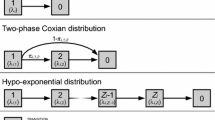Abstract
This paper proposes a new methodology to schedule activities in projects with stochastic activity durations. The main idea is to determine for each activity an interval in which the activity is allowed to start its processing. Deviations from these intervals result in penalty costs. We employ the Cross-Entropy methodology to set the intervals so as to minimize the sum of the expected penalty costs. The paper describes the implementation of the method, compares its results to other heuristic methods and provides some insights towards actual applications.
Similar content being viewed by others
References
Alon, G., Kroese, D. P., Raviv, T., & Rubinstein, R. Y. (2005). Application of the cross-entropy method to the buffer allocation problem in a simulation-based environment. Annals of Operations Research, 134, 137–151.
Bassok, Y., & Anupindi, R. (2008). Analysis of supply contracts with commitments and flexibility. Naval Research Logistics, 55(5), 377–491.
Ben-Tal, A., Golany, B., Nemirovski, A., & Vial, J. P. (2005). Retailer-supplier flexible commitments contracts: a robust optimization approach. Manufacturing & Service Operations Management, 7(3), 248–271.
Bendavid, I., & Golany, B. (2009, accepted). Setting gates for activities in the stochastic project scheduling problem through the cross entropy methodology. Annals of Operations Research.
Botev, Z., & Kroese, D. P. (2004). Global likelihood optimization via the cross-entropy method with an application to mixture models. In Ingalls, R. G., Rossetti, M. D., Smith, J. S., & Peters, B. A. (Eds.), Proceedings of the 2004 winter simulation conference (pp. 529–535). Washington: IEEE.
Buss, A. H., & Rosenblatt, M. J. (1997). Activity delay in stochastic project networks. Operations Research, 45(1), 126–139.
Cohen, I., Golany, B., & Shtub, A. (2005). Managing stochastic, finite capacity, multi-project systems through the cross-entropy methodology. Annals of Operations Research, 134, 189–199.
Elmaghraby, S. E. (2001). On the optimal release time of jobs with random processing times, with extensions to other criteria. International Journal of Production Economics, 74, 103–113.
Elmaghraby, S. E., Ferreira, A. A., & Tavares, L. V. (2000). Optimal start times under stochastic activity durations. International Journal of Production Economics, 64, 153–164.
Fazar, W. (1959). Program evaluation and review technique. American Statistician, 13(2), 10.
Golany, B., Dar-El, E. M., & Zeev, N. (1999). Controlling shop floor operations in a multi-family, multi-cell manufacturing environment through constant work-in-process. IIE Transactions, 31, 771–781.
Goldratt, E. M. (1997). Critical chain. Great Barrington: North River Press.
Heragu, S. (1997). Facilities design. Boston: PWS Publishing Company.
Herroelen, W. S., & Leus, R. (2005). Project scheduling under uncertainty: survey and research potentials. European Journal of Operational Research, 165, 289–306.
Herroelen, W. S., Van Dommelen, P., & Demeulemeester, E. L. (1997). Project network models with discounted cash flows: a guided tour through recent developments. European Journal of Operational Research, 100, 97–121.
Ignizio, J. P. (1982). Linear programming in single- & multiple-objective systems. Englewood Cliffs: Prentice-Hall.
Kimms, A. (2001). Mathematical programming and financial objectives for scheduling projects. Massachusetts: Kluwer.
Kolish, R., Sprecher, A., & Drexl, A. (1995). Characterization and generation of a general class of resource-constrained project scheduling problems. Management Science, 41(10), 1693–1703.
Kroese, D. P., Rubinstein, R. Y., & Porotsky, S. (2006). The cross-entropy method for continuous multi-extremal optimization. Methodology and Computing in Applied Probability, 8, 383–407.
Malcolm, D. G., Roseboom, J. H., Clark, C. E., & Fazar, W. (1959). Application of a technique for research and development of program evaluation. Operations Research, 7, 646–669.
Rand, G. K. (2000). Critical chain: the theory of constraints applied to project management. International Journal of Project Management, 18, 173–177.
Romero, C. (1991). Handbook of critical issues in goal programming. Headington Hill Hall: Pergamon.
Rubinstein, R. Y., & Kroese, D. P. (2004). The cross-entropy method—a unified approach to combinatorial optimization, Monte-Carlo simulation, and machine learning. New York: Springer.
Sobel, M. J., Szmerekovsky, J. G., & Tilson, V. (2009). Scheduling projects with stochastic activity duration to maximize expected net present value. European Journal of Operational Research, 198(3), 697–705.
Trietsch, D. (2005). Economically balanced criticalities for robust project scheduling and control. Working paper, ISOM Department, University of Auckland, New Zealand.
Trietsch, D. (2006). Optimal feeding buffers for projects or batch supply chains by an exact generalization of the newsvendor result. International Journal of Production Research, 44(4), 627–637.
Author information
Authors and Affiliations
Corresponding author
Rights and permissions
About this article
Cite this article
Bendavid, I., Golany, B. Predetermined intervals for start times of activities in the stochastic project scheduling problem. Ann Oper Res 186, 429–442 (2011). https://doi.org/10.1007/s10479-010-0733-y
Published:
Issue Date:
DOI: https://doi.org/10.1007/s10479-010-0733-y




